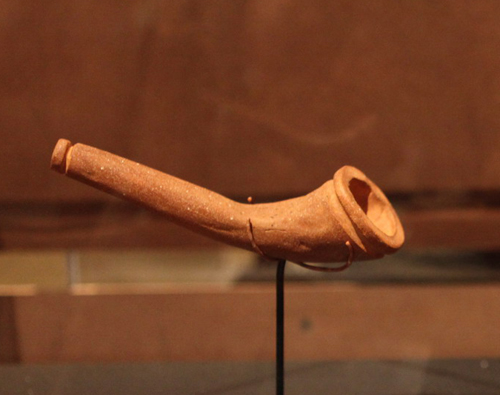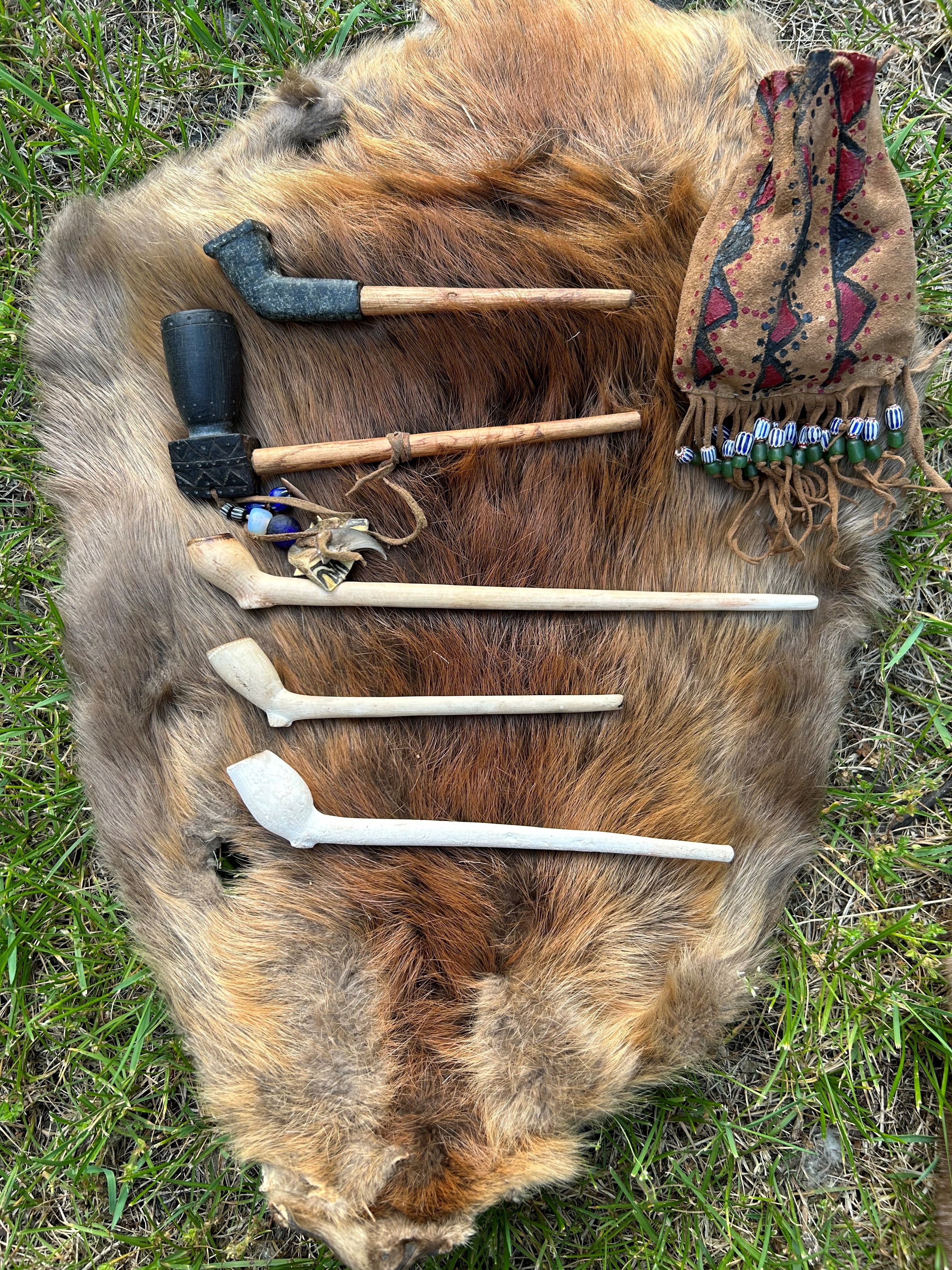
Museum of the City of New York, Amsterdam-New Amsterdam Exhibit
Please visit MCNY for more information:
http://www.mcny.org/
This tobacco pipe was made in 2009 by Rich Joseph for the MCNY exhibit Amsterdam-New Amsterdam. It is intended to represent a Native American tobacco pipe as one would have been made prior to contact with Europeans.
Tobacco Pipes and Tobacco Among the Algonkian People of Southern New Netherlands
Tobacco and the pipes made to smoke it have been part of the Algonkian culture for thousands of years. Nicotiana Rustica appears to be the most common variety cultivated by Algonkians of the southern New Netherlands colony area. A small three-foot plant in contrast to the towering and more familiar nine-foot Nicotiana tobaccum from the Caribbean, N. rustica is nevertheless considerably more potent, with a nicotine content of nine percent as compared to its cousin’s three percent. N. rustica grows leaves roughly half the size of the N. tobaccum, measuring a maximum of twelve inches long and six inches wide as opposed to N. tobaccum’s potential thirty inches long and eighteen wide. N. tobaccum’s large size gave it a particularly good yield as a cash or trade crop and was preferred by both colonial farmers and European markets.
Due to its potency and size difference, many Europeans did not care for Native Eastern Woodland tobacco, preferring the more mild tobacco grown in Virginia, South America and the Caribbean (typically N. tobaccum). In Algonkian society, it was traditionally a man’s job to grow the tobacco; it was believed that this practice would allow him to learn what it was to grow life, something that women already know. Tobacco was central to spirituality of the tribe’s men. Records of the Powhatan in Virginia describe, “Powhatan men cultivating a separate tobacco patch by themselves: at Paspahegh ‘there was a Garden of Tobacco, and other fruits and herbes.’”(1) Another seventeenth century reference states that “[tobacco] was dried over a fire, after which it was smoked predominantly by married men”(1).
Tobacco had to last the from growing season through the entire year, as it was used for most spiritual or ritualistic activities. Because of its smaller size and increased potency, Algokian peoples frequently mixed their tobacco with other herbs which not only extended the supply but added enjoyable flavors and even medicinal properties. In New Netherlands, Castorium (the castor gland of a beaver) was also used to flavor tobacco. Adriaen van der Donck noted in his 1647 book that, “the real castoreum is to be found in the females, and not in the males. The little round balls taken from the males, the Indians carve up and smoke with tobacco, which they say is wholesome and tasty”(2). Staghorn sumac leaves were also mixed with tobacco, as is described in the captivity narrative of James Smith (Scoouwa). Taken captive of the Mohawks in the Ohio territory in the 1750’s, Smith writes, “They seated me on a bear skin, and gave me a pipe, tomahawk, and polecat [weasel, mink or skunk] skin pouch, which had been skinned pocket fashion, and contained tobacco, killegenico or dry sumach [staghorn sumac] leaves, which they mix with their tobacco”(3).
Among Algonkian people, pipes, known as Apokan, Hobokan, Upokàn (originally meaning a stone pipe) were made of a variety of materials. The most common were clay and soapstone. Clay pipes could be made easily by rolling coils of clay, piercing it through with a narrow carved stick or grass, pinching the bowl of the pipe open by hand and drying the pipe leather hard in the sun. Designs could be carved or figures applied (sometimes the images of animals were added on with extra clay in the dry stage using wet clay) at this stage and once totally dry, the pipe would be fired along with the other pottery in a great wood pit fire. Many examples of these clay pipes survive in archaeological sites from New England to Virginia. John Brereton records this pipe style in 1602: “They gave us also of their tobacco, which they drink [smoke] green but dried into powder, very strong and pleasant, and much better than any I have tasted in England. The necks of their pipes are made of clay hard dried (whereof in that island is great store both red and white). The other part is a piece of hollow copper, very finely closed and cemented together…” (4).
Stone pipes were usually carved from soapstone or steatite. This rock, comprised mostly of talc, is very soft and easy to carve with stone tools. Like their clay counterparts, pipes made of soapstone have been found all over the northeast in a variety of sizes, shapes, and forms. In 17th century southern New Netherlands Colony, elbow style pipes both long and short were common, sometimes ornamented and others left relatively plain. To make a soapstone pipe, the rock must be acquired and shaped into a workable size, from there, hours of scraping and carving using stone tools (or by the 17th century, trade knives) creating the desired shape. Once the shape is made, the bowl is drilled out using a bow, pump, or hand drill.
Prior to contact the Europeans, Native American drill bits would have been made of chipped flint and chert, but by the 17th century, metal files and awls would have been common trade tools. These metal tools were particularly useful in carving the bowl to its desired width and thinness. Finally, the stone bowl would usually be fitted with a wooden pipe stem of ash or viburnum. These pipes could be difficult to carve depending upon their size and certain communities did not have ready access to quality soapstone. To fill this void, vast trade routes had been established to meet these needs. There is documentation from New England of both traded stone pipes as well Natives adapting new European materials for traditional pipe-making: “Generally all the men throughout the country have a tobacco bag with a pipe in it, hanging at their back. Sometimes they make such great pipes, both of wood and stone, that they are two foot long, with men or beasts carved, so big or massy that a man may be hurt mortally by one of them; but these commonly come from the Mohawks (or the men eaters), three or four hundred miles from us. They have an excellent art to cast pewter and brass into very neat and artificial pipes; They take their wuttammâug (that is, a weak tobacco) which the men plant themselves, very frequently; and yet I never see any take so excessively as I have seen in Europe; and yet excess were more tolerable in them, because they want the refreshing of beer and wine, which God hath vouchsafed in Europe”(5).
With increased contact beginning as early as the late 16th century and for southern New Netherlands colony, the 17th century, Europeans became very fond of tobacco. Learning from Native Americans about tobacco pipes, specimens were taken back in the late 16th century and reproduced by potters, creating the first European clay “tobacco pipe.” At first these pipes had only small bowl sizes since tobacco was an expensive commodity, but as tobacco became a trade crop in many different colonies, pipe bowls grew. These European pipes were made predominantly in England and the Netherlands of white kaolin clay. Individual pottery guilds made them on a massive scale, producing hundreds of thousands. These pipes would be packed in barrels and sent overseas to the colonies for colonial use, but they were also traded with Native Americans. These pipes were relatively cheap and slightly stronger than Native-made clay pipes. Also they were much longer than Native made clay pipes, which allowed the smoke to cool more effectively before inhalation, all of which made these pipes desirable. Clay pipes of European manufacture are even included among the goods traded in land deeds from the 17th century. A deed of sale from Ruckingheage reads: “This Indenture made the 15th of February 1651, Between Runckinheage, Piamikin, and Magise, and Towntom, and Winnapucke, and Magushetowes, and Concuskenow, and Wampasum, and Sasseakun, and Runckenunnett, and Pokessake, and Shoakecum, and So- anamatum, and Prodax, and Matumpun, and Cockeno-de-Long-Island, Indians, of the one Partie.and Richard Web, Nathaniel Eli, Matthews Marvin, senr., Nathaniel Richards, Isacke More, Thomas Fitch, Thomas Hales, Richard Holmsted, Richard Seamcr, Ralph Keeler, Matthew Marvcn, junior, Nathaniel Haies, Edward Church. Joseph Fitch, Planters of Nor- wake, for the use and behalfe of said Town, Witnesseth, that the said Runckinheage, and Piamikin, '&c. &c.) * * * * Have, and in and for the consideration of Thirtie Fathum of Wampum, Tenn Kettles, Fifteen Coates, Tcnn payr Stockings, Tenn Knifes, Tenn Hookes, Twenty Pipes, Tenn Muckes, Tenn needles, to them in hand paid, Have, and Every of them, for themselves and their heyers. Granted, Bargained, Sold, assigned, Enfeoffed, and con- firmed ; and by these Presents doth Bargain, grant, sell, enfeoffs, assignc, sett over, and confirme, unto the said Richard Web, (&c. &c.)(6)
- The Powhatan Indians of Virginia: Their Traditional Culture, Helen C. Rountree, University of Oklahoma Press copyright 1988, pg 47 paragraph 2.
- A Description of New Netherland, Adriaen Van Der Donck (1647), University of Nebraska Press, 2008, pg 126 paragraph 1
- Scoouwa: James Smith’s Indian Captivity Narrative , James Smith (1799) Ohio Historical Society, copyright 1978, 1992,1996, pg 30 paragraph 3
- Indian New England 1524-1674, Ronald Dale Karr, Branch Line Press copyright 1999, pg 108, paragraph 1, John Brereton (1602) 34-35
- Indian New England 1524-1674, Ronald Dale Karr, Branch Line Press copyright 1999, pg 108, paragraph 2. Roger Williams (1643) 43,72-73,211,12
- Norwalk, Charles M Selleck. 1896, Deed from Ruckingheage 1651, Norwalk CT, Pg 14, Paragraph 1
Drew Shuptar-Rayvis

From Top to Bottom
mid 17th century soapstone pipe
late 17th century keel pipe
1st clay pipe on top is a Dutch/ English 1640-1650
under it is a 1670’s English style clay pipe
and under that is a 1680’s -1690’s English clay pipe.
Photo by Drew Shuptar-Rayvis

